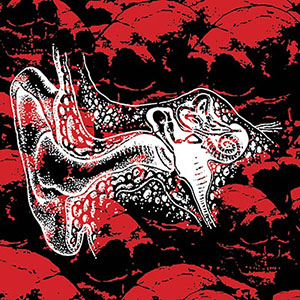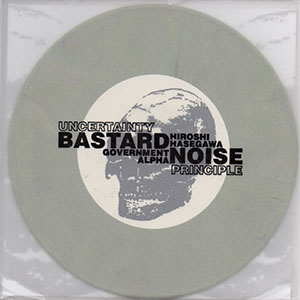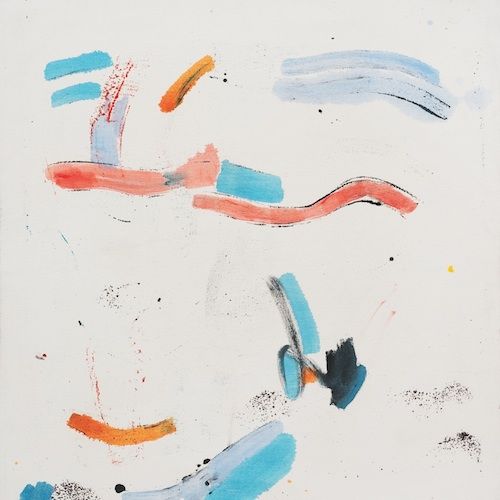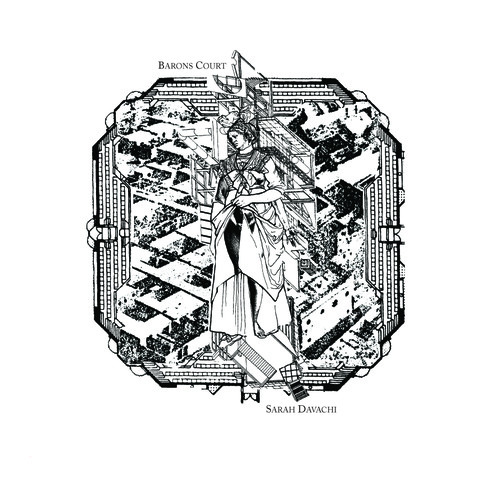- Administrator
- Albums and Singles
 Bastard Noise was not as prolific in 2014 as previous years, with only a handful of releases appearing. From that handful, these two are very different in their respective approaches, with Live at Babycastles consisting of a single long-form piece recorded by the duo of Anthony Saunders and Eric Wood, and Uncertainty Principle being two short pieces in collaboration with two well known Japanese artists. The sound, however, stays consistent: a subtle, at times ambient series of sounds that manage to get very noisy, but never lose their direction.
Bastard Noise was not as prolific in 2014 as previous years, with only a handful of releases appearing. From that handful, these two are very different in their respective approaches, with Live at Babycastles consisting of a single long-form piece recorded by the duo of Anthony Saunders and Eric Wood, and Uncertainty Principle being two short pieces in collaboration with two well known Japanese artists. The sound, however, stays consistent: a subtle, at times ambient series of sounds that manage to get very noisy, but never lose their direction.
Small Doses/RSM/Skull
The opening minutes of "Alien Mother Nest/Space Graves" from Babycastles are surprisingly hushed.Quiet, slow flanging tones are eventually mixed with very low frequency bass, almost below the range of human hearing.Bits of laser gun synth noise and subtle feedback drift in, but held at the same quiet volume.Things stay pretty calm until the duo crank the volume up, bringing in a passage that sounds like strings from the Psycho soundtrack stretched out into infinity.
Even as the volume builds, the performance by Saunders and Wood is more electro acoustic avant garde than harsh noise in nature.The near forty minute performance is an exercise in restraint, keeping the noise part of the project name to a minimum until the closing minutes.Even at the conclusion, when the distortion knobs are cranked up, the mix is kept controlled enough that the sound is never lost in a storm of white noise.
samples:
- Alien Mother Nest/Space Graves (Excerpt 1)
- Alien Mother Nest/Space Graves (Excerpt 2)
- Alien Mother Nest/Space Graves (Excerpt 3)

The 7" single of Uncertainty Principle, however, has Bastard Noise working with two legendary Japanese artists known for anything but their subtleness.With BN, however, each piece sounds exactly as it should:a blending of both artists.On "The Confusion Age," with Hiroshi Hasegawa (Astro, CCCC), Hasegawa’s spacy, psychedelic electronics are cut up to act as climaxes that are built up to, rather than a massive wall of noise.Taking a slow pace, the artists pair open, expansive moments with harsh noise outbursts, but in a very composed way, peppered with almost grindcore vocals.
"A Diabolical Journey," with Government Alpha (Yasutoshi Yashida) has a similar sound, but even slower and full of screechy, squelchy noises.Guttural vocals appear here too, painfully delivering the lyrics at a snail’s pace.BN and GA mix the harsher, distorted bits with bassy surges and ambient electronics, to create a significant amount of shifting and varying dynamics within the confines of a single piece.
Even though they have the word in their name, Bastard Noise do not choose to sit squarely in the harsh noise realm as many would expect.They may use some of the same sounds and strategies, but their work, especially on these two releases, strikes me as something much more composed and organized.There is nothing here that resembles that critique that noise is nothing but distortion and squall.
samples:
 
Read More
- Administrator
- Albums and Singles
A master of romantic abstraction, Jefre Cantu–Ledesma is not new to the scene. In fact, he's been releasing a steady stream of music for nearly twenty years. With the brilliant album A Year With 13 Moons, however, the ever–prolific Ledesma appears to be hitting a new high. Or low, depending on how you like to see things. More on that later. First, some background.
Born & raised in Texas, Ledesma's formative artistic years were spent studying painting & sculpture in San Francisco. He began playing & releasing music in 1996 and has developed a steady relationship as a collaborator – he's released notable collaborations with Liz Harris (aka Grouper) as Raum, with Alexis Georgopoulos in his Arp project and with their ensemble The Alps, as well as filmmaker Paul Clipson. Ledesma also founded the influential label, Root Strata, who have released music by Oneohtrix Point Never, Keith Fullerton Whitman, and Grouper, and continue to release new and archival works.
A Year With 13 Moons, a nod to a Rainer Werner Fassbinder film, was recorded at the Headlands Center for the Arts, just across the Golden Gate Bridge from San Francisco – where he and Clipson were artist in residence. It was a time of major transition. As he describes it, "the time at the Headlands was a real gift – of space, time and being cared for. This allowed me to create music in a way I never had before, on a day–in, day–out basis for hours on end. I stopped caring about end results and fell in love with the process. I learned how to let the music create itself in a way, to lead me rather than trying to force it down a path. I would start each session with a simple rhythm, or sound or a guitar riff & see where that led – it was cathartic, freeing and ultimately really transformed my approach to music making. In the end I was left with literally hours & hours of recordings. A Year With 13 Moons was culled from these and formed while traveling the week after I left the residence."
Using a friend’s reel-to-reel tape player, Cantu employed electric guitar, modular synthesizer, drum machine and concrète sounds from his surroundings at the Headlands, recorded while walking to the studio, cooking in the kitchen, talking with friends, the ocean, films he was watching, driving in a car. Everything was record stereo to tape. There is only one track with overdubs – otherwise each take is a true document of an entirely live take.
The result is gorgeous, haunting and sprawling. A companion to his last full-length LP, Love is A Stream, (Type, 2010), 13 Moons is a dense, swirling mass. A bookend to the end of a relationship. To say 13 Moons is comprised of "songs" might not be entirely accurate. They're closer to transmissions from a satellite of love. Opener "The last time I saw your face" sets the tone. A bittersweet goodbye letter that unites guitars and modular synthesizer to widescreen ends over the course of its 8 and half minutes. It works dramatically well as an opening statement, and also as a summary of what he's been doing in recent years. Second track, "In and Out of Love,” on the other hand, seems to represents where Cantu might be going.
Cantu was interested in ways of "conveying memory in music without being sentimental – somehow translating the fog of images, people and places that (he'd) experienced in the last two years into a body of work that could still be ambiguous & leave space for the listener to enter." As such, 13 Moons succeeds. Incisive editing allows hypnotic guitar and drum performances to be interrupted by Modular synth squalls and otherworldly textures –– combining overdriven guitars, avant-garde composition (a la Xenakis) with the informal approach of underground tape weirdos (like Robert Turman, K. Leimer) into a lovely brocade of harmony and dissonance.
Tracks like "Shadows," "Early Autumn" and "The Isar" bring these avant-gardisms to the fore, conjuring early experiments in industrial sound. "A portrait of you at Nico’s grave, Grunewald, Berlin (For B.K.)" might represent the album's loneliest moment, the air moving in hovering cloud formations. It would be perfect to soundtrack a Werner Herzog film. "Body of Moonlight" allows hope, a disappearing presence in the latter stages of 13 Moons, to resurface. It's a feeling Ledesma is very good at. That sense of something very intense at hand, and that fracturing sense of looking down at yourself. It's a feeling nearly impossible to describe. Then again, if words can't convey something, sometimes sound is better.
More information can be found here.

Read More
- Administrator
- Albums and Singles
After America is the first solo album by Simon Crab - most well-known as the founder and front-man of the group Bourbonese Qualk (1979-2003). The album contains 20 new tracks recorded from 2010-2014 at various locations in the UK and featuring contributions from Geoff Leigh (Henry Cow, ExWiseHeads) and Dave Smith (Guapo).
"An audio tapestry, After America is a tonal epic poem of moods and texture that narrates an intense emotional journey. Instrumental melodies from horn, wind, drum kits, acoustic and electric guitar and even Gamelan percussive arrangements verge on orchestral as they relate tumultuous tales and respite in oasis' of calm. At moments, the instrumentals are pierced by Industrial-strength synths and machine drums; other moments are cocooned in shimmering electronics that echo Basic Channel at their most sublime; and still others are haunted by misty ambientdrone. Instrumental bard, Simon Crab seamlessly blends otherwise disparate textures into a cohesive narrative while dragging the music (and listener) through a "hall of mirrors" that flirt with psychedelics. Rather than push his sounds through exaggerations, Crab accentuates and emphasizes using real-time audio synthesis, Supercollider, to instill a distinctly 'other' quality. What might have passed as improvised, minimal folk, or traditional/ethno/postjazz is actually a kind of 'cyborgmusic,' a surprisingly harmonious blend of natural and synthetic. After America heralds the end of a colonial Empire that flails in a Brave New World where ideas and change fire across the globe and the speed of thought. In the way that a masterfully woven tapestry depicts tales, so too does After America, taking you on an Odyssey with each listen.
Simon Crab has been a music maker since the late '70s, where he founded Bourbonese Qualk, as well as Sunseaster, an experimental/improvised/electroacoustic noise project. Crab also learned traditional African and Middle Eastern music and is a member of London's Gamelan orchestra."
-Ibrahim Khider, Toronto, 2014
More information can be found here and here.
Read More
- Administrator
- Albums and Singles
Fantastic Planet is the soaring, evocative new album from Noveller, the solo instrumental venture of Austin-based composer and filmmaker Sarah Lipstate. The LP is a journey through eclectic sonic terrain, blending rich waves of synth with soaring cinematic guitar lines, guiding the listener through Noveller's most diverse and compelling release to date.
Originally self-defined as an electric guitar project, Lipstate began recording under the name Noveller (pronounced "know-veller") in 2005 whilst living and studying in Texas. She uprooted to Brooklyn and subsequently made waves on New York's live scene and internationally, sharing the stage with the likes of Six Organs of Admittance, St. Vincent, Xiu Xiu, the Jesus Lizard, U.S. Girls, Aidan Baker and Emeralds, whilst capturing the attention of NPR, The Village Voice, Time Out New York and The Wall Street Journal.
Noveller's prolific output has seen her release albums via No Fun Productions and her own imprint, Saffron Recordings, including the Desert Fires LP and the critically acclaimed Glacial Glow. She also released a split LP with unFact (David Wm. Sims of the Jesus Lizard) and has collaborated with several renowned musicians, including live improvised duo performances with Carla Bozulich (Evangelista, The Geraldine Fibbers), Lee Ranaldo (Sonic Youth), and JG Thirlwell (Foetus, Manorexia). She has previously performed as a member of Cold Cave, Parts & Labor, and One Umbrella.
Upon returning to Texas, Lipstate developed her signature cinematic soundscapes further, and it was here she completed her spectacular new release Fantastic Planet. It is an album largely steeped in place, both real and fantastical, and influenced by Lipstate's various interchanges and relocations, physical and emotional.
Noveller takes the elements of rhythm and synth textures introduced in her previous album No Dreams and expands them to a new level of prominence through her guitar work on Fantastic Planet. From the dark beat propelling "Pulse Point" to the distorted synth on post-punk track "Rubicon," Lipstate pushes her sound in new directions that complement and elevate her intoxicating filmic soundscapes.
More information can be found here.

"Some artists traverse boundaries. Sarah Lipstate's work seems to come from a world where they never existed. Her color-rich visual art has a mournful literary quality to it; her short films trigger collisions of emotional crosscurrents; and her instrumental music, which she makes under the name Noveller (emphasis on the middle syllable), seems to call to attention all senses at once, to the point where even the word music seems somehow limiting." - Time Out NY
"...simultaneously soothing and mind-wrecking noise, along with a compositional depth that most loud-for-the-hell-of-it guitar droners never reach." - NY Press
"...hypnotic, rich-textured electric guitar works." - New York Times
"Sarah Lipstate creates miniature musical worlds, places that you feel like you'll never leave long as the record is playing." - Pitchfork
Read More
- Administrator
- Albums and Singles
 Considered "lost" for the better part of the past decade, these two live pieces, commissioned for a performance in Berlin, has some unexpected moments for those familiar with these two composers. Steve Roden and Frank Bretschneider blend their strengths of subtle electronics and improvisation, but also bring in some surprisingly conventional beats and rhythms, resulting in an unpredictable, yet diverse and gripping record.
Considered "lost" for the better part of the past decade, these two live pieces, commissioned for a performance in Berlin, has some unexpected moments for those familiar with these two composers. Steve Roden and Frank Bretschneider blend their strengths of subtle electronics and improvisation, but also bring in some surprisingly conventional beats and rhythms, resulting in an unpredictable, yet diverse and gripping record.
The first piece, performed live for the 2004 Suite in Parochial festival, immediately begins with a surprising use of beats.The deep synthetic thuds, approximating 4/4 kick drums without fully sounding like a drum machine, lie somewhere between the electronic noise style of Raster-Noton and the submerged dub of the Basic Channel label.The duo continue this bizarre techno sound via tiny synthetic outbursts and bits of noise, drifting towards bleepy skittering techno that never manages to go full on dance in its structure.
From this misleading trip down rhythmic avenues, Roden and Bretschneider then choose to completely change things around.Rather than beats, the performance becomes heavy with crackling drones and massive sub bass passages.The middle segment features some stretched out DSP bell tones that sound nice in this context, but are a bit less distinctive than the rest of the performance.The duo eventually mangles what could almost pass for a harmonica melody, and closes the piece on a rhythmic, synth heavy conclusion.
The second piece, a recorded rehearsal, sounds like the duo working with the same settings and instrumentation, but the result is notably different in its style and structure.They retain the bass heavy drones from before, but first focus on abstract synth loops:a drastic departure from the beat centric opening of the live performance.Organic clinking and dripping sounds appear, making for a more textural introduction.
Compared to the performance, the rehearsal is less rhythmic and structured, instead seeing the two experiment with tones and textures.The hints at melody from before appear as well, but contorted and processed to be even more deranged than what was heard by the audience.The piece is just as dynamic as the other, but sounds even more experimental.The final ten or so minutes of the piece drift into that glitch heavy techno sound that characterizes what became the actual performance.
Considering that both of these lengthy pieces were performed solely by Bretschneider’s modular synth, with Roden manning effects, recordings, and various objects, the end result is far richer and nuanced than the instrumentation would suggest.Having sat in some digital limbo for the past decade, these two related, yet thematically similar performances finally seeing the light of day is a very good thing.
samples:
 
Read More
- Administrator
- Albums and Singles
Summoning Suns is James Blackshaw's tenth studio album and the first recording to feature his voice and lyrics. Drawing inspiration from '60s and '70s singer-songwriters, baroque/orchestral pop and folk music, while still sounding contemporary, Summoning Suns is Blackshaw's foray into more traditional forms of songcraft.
Blackshaw sings in a gentle but assured voice while his words combine his personal experiences, neuroses and fantasy through many layers of abstraction, poeticism and dark humour.
While the deft fingerpicking acoustic guitar style of Blackshaw's previous recordings is still a prominent part of the sound, the songs are lushly and intricately arranged for drums, bass, piano, violin, flute and pedal steel guitar and features contributions from Simon Scott (Slowdive), Annie Nilsson and Japanese musicians Mori Wa Ikiteiru and Kaoru Noda (with whom he duets in Japanese on one song).
Summoning Suns will be released in the US on Important Records on February 17th. More information can currently be found here.

Read More
- Administrator
- Albums and Singles
Realized over a four-year period, Sean McCann's Ten Impressions for Piano & Strings is a document of transition and maturation. Slow-moving cloud forms over corporeal landscapes, these impressions whisper of McCann's imminent & decisive lean towards classical & avant-garde musics, culminating in 2013's Music for Private Ensemble on his own imprint, Recital. Less a final statement on ambient music, more a meditation on change, discovery and process.
More information can be found here.

Read More
- Administrator
- Albums and Singles
Miscontinuum Album documents an impressive new work by seminal electronic musician Jan St. Werner, whose innovations with Mouse on Mars and Microstoria are well-documented. Over a period of approximately four years, Miscontinuum has been developed and refined as an operatic live performance in Munich, as well as a radio play. This recorded incarnation of the work is the third entry in Werner's lauded Fiepblatter series, and features contributions by Dylan Carlson (Earth), Markus Popp (Oval), Kathy Alberici, and Taigen Kawabe (Bo Ningen). It is a challenging listen not compromised for casual music consumption habits, but with time and close listening, it yields vast rewards. Miscontinuum Album is a radical convergence of sound exploration and storytelling that has few precedents.
The central concept of Miscontinuum explores misconceptions of time and memory, inspired by unique acoustic phenomena derived digital phasing and musical time-stretching techniques. There is an aura of doom that pervades the work. Much of the album's evocative nature comes from the interplay of Werner's electronics with Alberici and Kawabe's voices and the contrast between those organic and inorganic elements. Popp, a longtime collaborator with Werner in Microstoria, wrote the libretti, which is presented in five distinct scenes and recited redolently by Carlson. The surreal plot involves a progressive distinction of time as a force rather than a structuring system, and an individual who can shift consciously between states within that force. The high concepts and unusual creative partners combine for an album that is uncommonly emotionally resonant.
Miscontinuum was first performed as a part of Werner's Asymmetric Studio series in Munich on June 18th, 2013, and also featured video by Werner and Karl Kliem and stage design by Christina del Yelmo & Sonia Gomez Villar. It was broadcast by Bayerischer Rundfunk public radio ten days later. The striking visual elements, flowing dresses and impressionistic masses of color, make appearances on the album's art, and will be presented in new forms in the coming months. The first revised version of the Miscontinuum, featuring live video by Zoya Bassi, will premiere at the St Luke's Church in London on Feb 8th 2015 and is the first in a series of more shows to come in 2015.
More information can be found here.

Read More
- Administrator
- Albums and Singles
Barons Court is the debut full-length album by Canadian electroacoustic composer Sarah Davachi, following short-run releases on Important Records' Cassauna imprint and Full Spectrum.
Trained at Mills College, Davachi's work marries an academic approach to synthesis and live instrumentation with a preternatural attunement to timbre, pacing, and atmosphere. While the record employs a number of vintage and legendary synthesizers, including Buchla's 200 and Music Easel, an EMS Synthi, and Sequential Circuit's Prophet 5, Davachi's approach to her craft here is much more in line with the longform textural minimalism of Eliane Radigue than it is with the hyper-dense modular pyrotechnics of the majority of her synthesist contemporaries.
Three of the album's five compositions feature acoustic instrumentation (cello, flue, harmonium, oboe, and viola, played by Davachi and others) which is situated alongside a battery of keyboards and synths and emphasizes the composerly aspect of her work. "Heliotrope" slowly billows into being with a low, keeling drone that is gradually married to an assortment of sympathetic, aurally complex sounds to yield a rich fantasia of beat frequencies and overtones. Later, "Wood Green" opens almost inaudibly, with lovely eddies of subtly modulating synth clouds evolving effortlessly into something much larger, as comforting and familiar as it is expansive. In an era in which the synthesizer inarguably dominates the topography of experimental music, Davachi's work stands alone - distinctive, patient, and beautiful.
More information can be found here.

Read More
- Administrator
- Albums and Singles
Medical Records presents a hand-picked selection of the early recordings of Germany's Bal Paré.
The band started as Jeanette & das Land Z in 1981 with a 7“ on Konkurrenz Rec./ Phonogram which included two cover versions (a piece from a weird science fiction TV series soundtrack and a sixties Grand Prix Eurovision number one hit). The 7” became an underground hit.
The band then changed their name to Bal Paré and begin recording independently. The band name was based on the song "Es war beim Bal Pare" from the German chansonette Hildegard Knef, which was a musical influence beside bands like Kraftwerk, Depeche Mode, Erasure, Yazoo, etc.
The first Bal Paré LP, Hamburg-Paris-Catania, was released in 1982 on Konkurrenz Records. Since they had a large fanbase in Sweden, the second release (Metamorphose) came out in Stockholm on the Krautrock label.
Shortly after, the band experienced a major line-up upheaval. There were many tracks produced during this time that ended up unreleased. Much of the material from this selection of tracks were culled from those unreleased sessions (which were later collected on the “Best of” CD-only release in 1996 on Tatra Records).
The original two LPs are long out-of-print and demand very high prices on the collectors market. This is the first time this collection has been reissued on vinyl.
The opening track "Rien" is a perfect display of what synth pop is modeled after: rich lead synth textures, male/female interplayed vocals, and electronic percussion. Though the entire record flows with ease and captivates the listener from beginning to end, other stand-out tracks include "Palais d’Amour," "Die Idioten," and "Meilleur Du Monde." This collection is absolutely crucial for fans of early new wave such as Deux, Moderne, Performance and other similar acts of the genre.
The tracks have been lovingly restored by Matthias Schuster.
More information can be found here.

Read More
- Administrator
- Albums and Singles
Active since 1979, Maurizio Bianchi is an Italian pioneer of noise and industrial music.
Untitled 1980 was originally released in 1980 on cassette in Japan. This release marks the first re-issue of this work and pairs it with a 2013 re-working of the original material into four entirely new compositions.
This work was created using only a single semi-modular, monophonic synthesizer or, as Maurizio says:
"Originally composed in October 1980 simply by using a synthesizer KORG MS20, but with so much imagination. Dedicated to technological sophistication."
More information can be found here.

Read More

